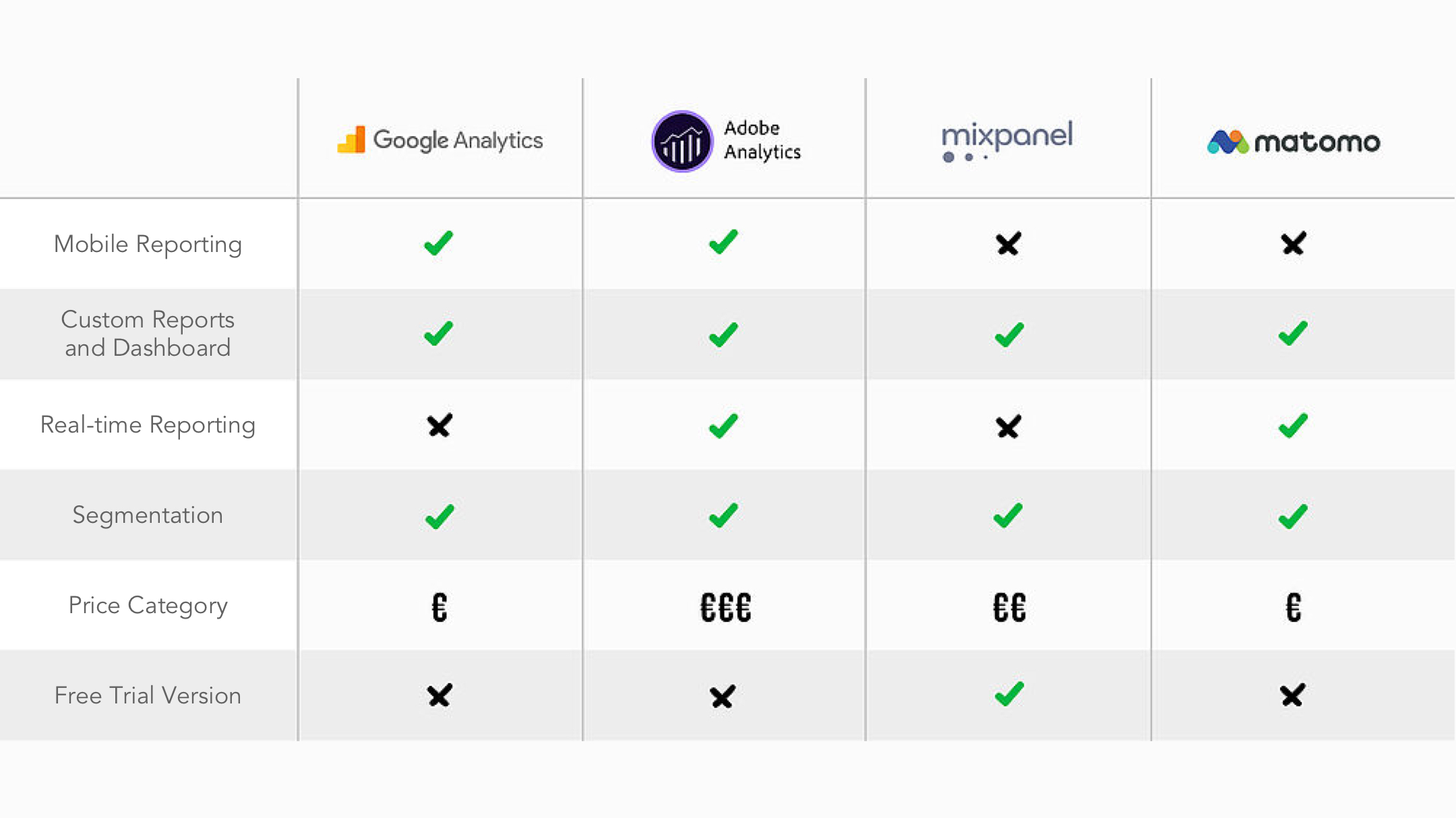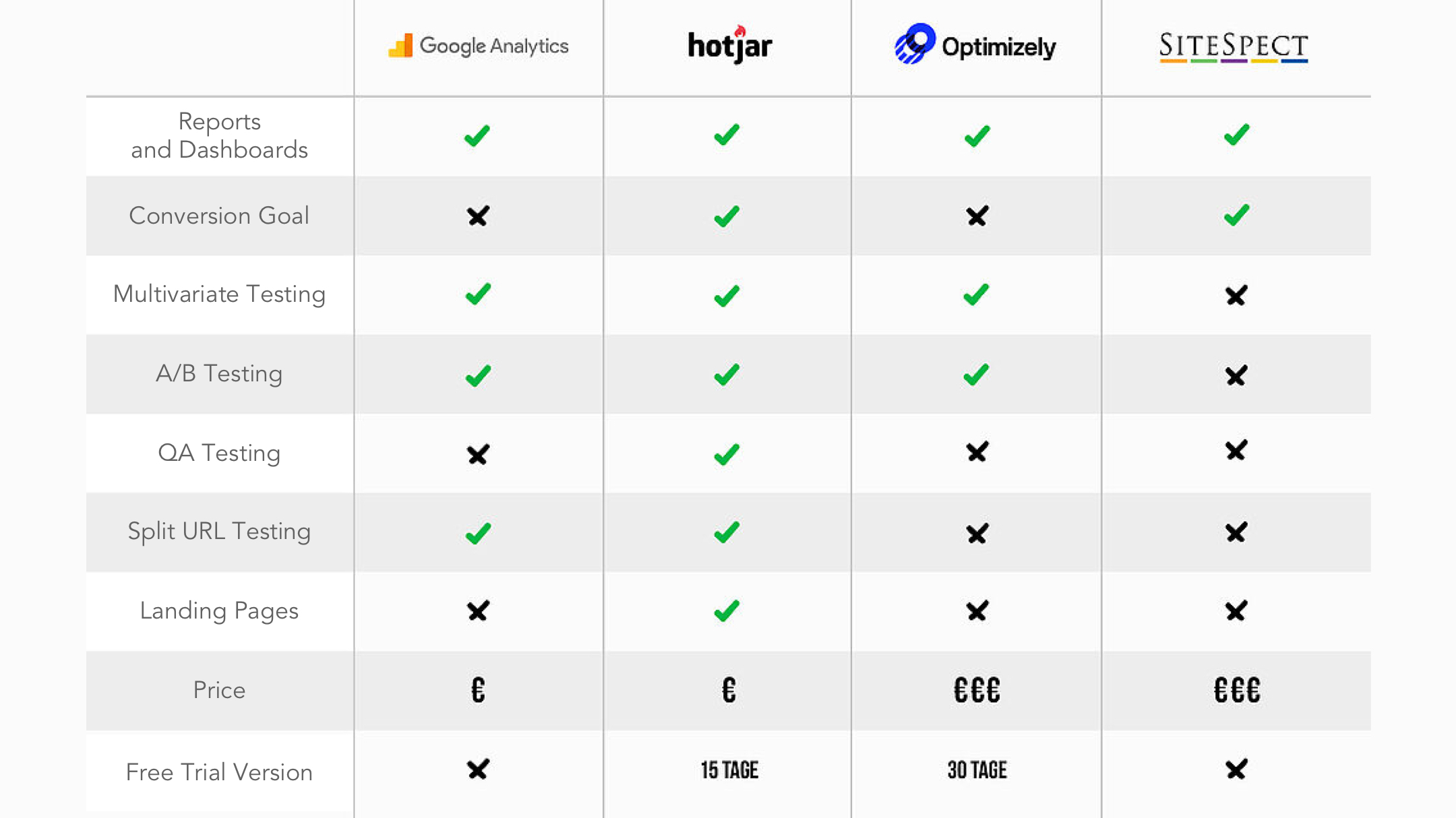In our article "What is tracking and what is it useful for?" we looked at the topic of tracking and explained why tracking is important for monitoring success in online marketing. In order to be able to evaluate data that users leave on a website, a web analysis tool is required. We have already touched on the basics that are needed for such a tool.
Today we would like to introduce the most well-known of these web analytics tools and their functions to make it easier for you to select the best tool for your individual problem. We will also look at A/B testing tools. We also give tips on how to distribute capacity sensibly in your company and on economic aspects that you should consider when tracking.
For those who have not yet actively dealt with the topic of tracking, the selection of analysis tools on the Internet may be a bit too much. We would therefore like to provide an overview of the most popular tools below: What are the functions that each tool offers? What are the advantages and disadvantages? And is there an option to test the tool before I decide to buy it?
With Google Analytics, Google offers the most widely used web analytics tool. The basic version of the tool is free. In order to be able to access statistics, a tracking code must be installed on the website. Google Analytics is suitable
Pros
Cons
Adobe Analytics is part of Adobe's in-house Marketing Cloud. Prices must be requested individually from Adobe. Adobe Analytics is suitable
Pros
Cons
Mixpanel measures events on the web on the one hand, and visitors on the other. You don't pay a flat rate, but for individual events that are tracked. Mixpanel is useful
Pros
Cons
Matomo is an open source solution that is hosted by the user, not by an external service provider. This eliminates licensing costs. As with Google Analytics, a tracking code must be installed on the website for statistical analysis. The full PIWIK Pro suite is still available. Matomo is suitable
Pros
Cons
The following table provides an overview of the tools mentioned, in which we briefly compare the functions:

A/B testing tools are standard for testing the usability, layout and design of advertising materials. A/B testing can be used to optimize page layout, for example, to determine where on a page a CTA (call to action) is most effective. Content can also be tested to see if the "order as a guest" option is better received by customers than the "no guest order" option. In addition, multivariate testing can help determine which content on a single page is best received by the target audience. Some A/B testing tools offer multivariate testing.
The web analytics tool Google Analytics includes Content Experiments, a solid free A/B testing tool. This can be used to test different variants of a page. Google Analytics also offers the ability to run multivariate tests.
Google Optimize is another testing tool from Google that is connected to Google Analytics. It is also free. Big plus: Google Optimize has a visual editor that allows you to modify and test pages without any knowledge of HTML.
Sitespect is used to target on- and off-site behavior. The tool also offers (retrospective) segmentation, real-time reporting and personalization. There are also options for cloud or enterprise use.
A plus: No tags or JavaScript are required for testing, which means less latency.
Hotjar tracks user visits and can capture their behavior in great detail. You can see where users move their mouse, what they click on, and where they hesitate. Users can also be asked questions to gain insight into the quality of the user experience. Like Google Analytics, Hotjar allows for multivariate testing. Strictly speaking, however, Hotjar is not an A/B testing tool, but an on-site experience analysis tool.
Optimizely enables design optimization and algorithmic conversion optimization. For example, conversion optimization is performed using a content recommendation engine. The tool can also be used to perform multivariate testing. Unfortunately, Optimizely is not available for free.

After reviewing the most common tracking tools and their features, here are a few tips for using your tracking setup in a resource-efficient way.
Many companies set up a dedicated tracking department to evaluate analytics tools. As a result, they are often inundated with requests from multiple departments and struggle to keep up with the pace of reporting. Requests often take weeks or even months to process.
We recommend that you divide up the tasks: Analytics experts gather verified data. The business departments then access these sources and create the reports themselves. Ideally, departments should be able to choose which tool they prefer to work with.
Of course, the cost-benefit ratio must also be considered for a successful tracking setup. If you buy an expensive tool with a lot of features, you have to realize that someone will have to take the time to analyze all the data. So it doesn't make sense to invest in an expensive tool and then not have the budget to implement the optimizations.
It's better to use a free tool first and see if it's sufficient for the project's purposes. If you find that you need more features, you can always upgrade. In any case, you should weigh things carefully and not make any hasty purchases.
If you need help deciding which tool to use, or just have a few questions about tracking, we are here to help. You can reach us by phone at +49 711 184206-0 or by email at hello@wus.de.